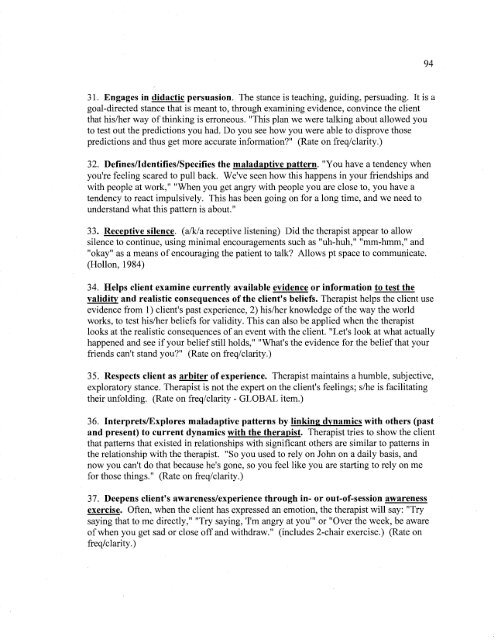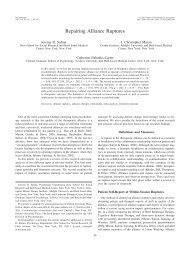Download - The Safran Lab
Download - The Safran Lab
Download - The Safran Lab
You also want an ePaper? Increase the reach of your titles
YUMPU automatically turns print PDFs into web optimized ePapers that Google loves.
31. Engages in didactic persuasion. <strong>The</strong> stance is teaching, guiding, persuading. It is a<br />
goal-directed stance that is meant to, through examining evidence, convince the client<br />
that his/her way of thinking is erroneous. "This plan we were talking about allowed you<br />
to test out the predictions you had. Do you see how you were able to disprove those<br />
predictions and thus get more accurate information?" (Rate on freq/clarity.)<br />
32. Defines/Identifies/Specifies the maladaptive pattern. "You have a tendency when<br />
you're feeling scared to pull back. We've seen how this happens in your friendships and<br />
with people at work," "When you get angry with people you are close to, you have a<br />
tendency to react impulsively. This has been going on for a long time, and we need to<br />
understand what this pattern is about."<br />
33. Receptive silence, (a/k/a receptive listening) Did the therapist appear to allow<br />
silence to continue, using minimal encouragements such as "uh-huh," "mm-hmm," and<br />
"okay" as a means of encouraging the patient to talk? Allows pt space to communicate.<br />
(Hollon, 1984)<br />
34. Helps client examine currently available evidence or information to test the<br />
validity and realistic consequences of the client's beliefs. <strong>The</strong>rapist helps the client use<br />
evidence from 1) client's past experience, 2) his/her knowledge of the way the world<br />
works, to test his/her beliefs for validity. This can also be applied when the therapist<br />
looks at the realistic consequences of an event with the client. "Let's look at what actually<br />
happened and see if your belief still holds," "What's the evidence for the belief that your<br />
friends can't stand you?" (Rate on freq/clarity.)<br />
35. Respects client as arbiter of experience. <strong>The</strong>rapist maintains a humble, subjective,<br />
exploratory stance. <strong>The</strong>rapist is not the expert on the client's feelings; s/he is facilitating<br />
their unfolding. (Rate on freq/clarity - GLOBAL item.)<br />
36. Interprets/Explores maladaptive patterns by linking dynamics with others (past<br />
and present) to current dynamics with the therapist. <strong>The</strong>rapist tries to show the client<br />
that patterns that existed in relationships with significant others are similar to patterns in<br />
the relationship with the therapist. "So you used to rely on John on a daily basis, and<br />
now you can't do that because he's gone, so you feel like you are starting to rely on me<br />
for those things." (Rate on freq/clarity.)<br />
37. Deepens client's awareness/experience through in- or out-of-session awareness<br />
exercise. Often, when the client has expressed an emotion, the therapist will say: "Try<br />
saying that to me directly," "Try saying, 'I'm angry at you'" or "Over the week, be aware<br />
of when you get sad or close off and withdraw." (includes 2-chair exercise.) (Rate on<br />
freq/clarity.)<br />
94



